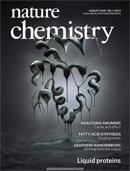 A few months ago I mused about the persistence of an urban myth of chemistry - the meaning of the p in pH. The musings grew into an essay which appeared in Nature Chemistry in August. [Urban legends of chemistry, Nature Chemistry 2, 600 (2010) - caveat, you or your institution need to have a subscription]. The in vivo behavior of the enantiomers of thalidomide turns out to be grist for another persistent myth.
A few months ago I mused about the persistence of an urban myth of chemistry - the meaning of the p in pH. The musings grew into an essay which appeared in Nature Chemistry in August. [Urban legends of chemistry, Nature Chemistry 2, 600 (2010) - caveat, you or your institution need to have a subscription]. The in vivo behavior of the enantiomers of thalidomide turns out to be grist for another persistent myth."Ryoji Noyori, who shared the 2001 Nobel Prize in Chemistry for his contributions to asymmetric synthesis, uses the tragedy of thalidomide to open his Nobel lecture: 'A compelling example of the relationship between pharmacological activity and molecular chirality was provided by the tragic administration of thalidomide to pregnant women in the 1960s. (R)-Thalidomide has desirable sedative properties, while its S enantiomer is teratogenic and induces fetal malformations. Such problems arising from inappropriate molecular recognition should be avoided at all costs.'A close reading of these tales raises more than a few flags. Details differ — was thalidomide marketed for depression or insomnia or morning sickness or to prevent miscarriage? (No, yes, yes and no.) Here is another urban legend of chemistry — with multiple authoritative sources, varying in detail, superficially reasonable, persistent — and with an incredibly compelling plot line. Yet it's not true — as even the tellers acknowledge on occasion. Both forms are teratogenic when administered, as they rapidly racemize in vivo.
Why would chemists pass on urban legends (and ones known to be false, at least in part)? Carl Jung suggested that 'no intellectual formulation comes near the richness and expressiveness of mythical imagery'" ....[read the rest at Nature Chemistry]
Prof. Israel Agranat (whose paper about chiral switches I reference in the essay) wrote me to share that it's not only chemistry textbooks in which these myths circulate. He pointed me to examples, including this one, from the law literature:
Citalopram is a racemate... Such molecules are called chiral (from χειρ, a hand) because, like a pair of hands, they are mirror images which cannot be completely superimposed on each other. They are conventionally designated (+) and (-). It has been well known for many years that, despite their similarities, the two enantiomers may bind to different proteins and produce different biological effects. The most notorious example was thalidomide, which consisted of a (+) enantiomer which was effective to prevent morning sickness in pregnant women and, unknown to the consumers, a (-) enantiomer which was teratogenic and caused severe birth defects." — excerpted from Lord Hoffman's decision of the England and Wales Court of Appeal in the Escitalopram oxalate (Cipralex, Lexapro in the US) patent litigation, H. Ludbeck A/s vesus Generics (UK)So why do we pass on the legends? My short answer is that resistance is futile!
















Perhaps this is an example of where greater general awareness of these problems in our society would raise more global protests to such problems.
ReplyDeleteI will read the article. It looks good.
I've seen thalidomide used as an example several times. In the best cases it is explained that if it were possible to administer just the one enantiomer then the terrible side effects could be avoided. They then go on to explain that it isn't possible for precisely the reason you state - racemization in vivo. I wonder if the persistence of this particular urban myth is a result of those who cite it not reading beyond the first part?
ReplyDeleteThis persists because it's simple. And because it persists. I always mention it in my Chem1 lectures, before going on to say "Actually, it's not that simple of course." One needs a serious example as a counterpoint to limonene, however. There's a nice example related to the drug I work on, praziquantel: 10.1371/journal.pntd.0000357. The bitterness of the inactive enantiomer causes serious problems of compliance in Africa.
ReplyDeleteSteve, Noyori certainly knows that it's not true, he refers to it in the notes that accompany the published lecture, so it's not ignorance that drives this.
ReplyDeleteMat, thanks for the much better example! I always use limonene, particularly with novice audiences, since it's so visceral (I teach a pretty international crowd, so bring samples to smell, not every knows caraway), but you're right, the consequences are only culinary, not life or death.
I suspect at least one reason the legends persist is because of the "seriousness" of the example, which really underscores that what we do matters.
I'd argue that we pass on the legends because we think we (being scientist that stand above the emotional behavior of the general public) are immune to passing on false information.
ReplyDelete